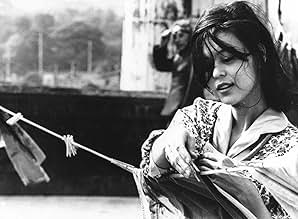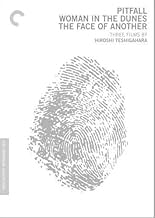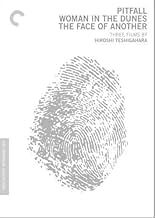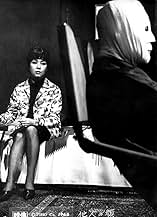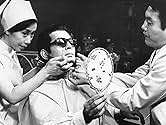A businessman with a disfigured face obtains a lifelike mask from his doctor, but the mask starts altering his personality.A businessman with a disfigured face obtains a lifelike mask from his doctor, but the mask starts altering his personality.A businessman with a disfigured face obtains a lifelike mask from his doctor, but the mask starts altering his personality.
- Awards
- 2 wins total
Robert Dunham
- Foreign man in Bar
- (uncredited)
Featured reviews
After an industrial accident that leaves his face disfigured for life, Mr. Okuyama (Tatsuya Nakadai)begins to question the meaning of life and his own identity, should he keep working, will his disgusted wife ever sleep with him again. His psychotherapist offers him the chance to avail of an illegal medical practice that he has invented, it's a mask moulded from the face of another, that Okuyama can wear to live life a little more normally. The mask gives him a new lease of life, but his therapist warns him that the mask could take over and influence him to do evil things. As the mask takes control Okuyama can't resist but to give in to his baser instincts, his main plan being, to seduce own wife, that he believes may be cheating on him anyway. With thematic echoes of Franju's Les Yeux sans visage and even Delmer Daves Dark Passage, Teshigahara delivers his expressionistic adaptation of Kôbô Abe's novel with style, the results being a dark and epic tale that will haunt its viewers. Its full of inventive visuals and clever tricks with sound, which along with Tôru Takemitsu's superb score contribute wonderfully to the theme of how fragile identity really is and how the masks we all wear hide our true beings and souls. There's also a secondary story of an unnamed facially deformed girl, who is also struggling to cope with her disfigurements and her tragedy is equally moving.
Mr. Okuyama (Tatsuya Nakadai) is a physically and emotionally wounded man. After an industrial accident at work, his face has been scarred and mutilated beyond recognition, and even his wife rejects him, even though she says his physical appearance doesn't matter. It has left him bitter and angry, until his psychiatrist Dr. Hira (Mikijiro Hira) comes up with a way to fashion a 'face mask' that will give him the appearance of having a completely normal face, albeit with a few joining marks. Hira doesn't do this just out of kindness, he is fascinated how this new face will alter Okuyama's personality and way of life.
The Face of Another is a fascinating film that highlights the social attitudes to physical appearance. There are hundreds of films and morality tales that teach you that it is inner beauty that counts, and once you allow this to shine then your physical attractiveness becomes irrelevant. Everyone knows that this is bullshit, so its refreshing to see a film that makes it clear from the outset that physical appearance has a massive part to play in society. Okuyama's new face, which is an attractive one, changes him so much that he takes on an almost dual identity. Dr. Hira delights in telling him that he has bought flashy new clothes, something he was never concerned with before. It becomes clear that whilst before Okuyama merely wanted to be normal again and fit back in society, his new face is engulfing him, and to be 'normal' simply isn't enough anymore.
As with many of the Japanese New Wave film-makers of the 1960's-70's, director Hiroshi Teshigahara takes some bold steps and sneaks in some surrealist and art-house values in a movie that is otherwise played relatively straight. A 'fictional' character appears every now and then throughout (she is first imagined by Okuyama's wife as a character in a movie); one side of her face is scarred and burned. She appears quite rarely, but seems to serve as an alternative to Okuyama's increasingly vain soul. Another scene seems a ball of hair that floats in the air, unnoticed by the people in the laboratory. I have no idea what it meant, and couldn't really admit to it being wholly successful, but it certainly got my attention nonetheless.
A powerful, disturbing, and poignant drama/horror from the greatest era in Japanese cinema. The film seems all the more important now, 45 years on, in a world where a botox injection can be as easy as buying a pack of cigarettes, and where physical 'beauty' is less a bonus than a necessity.
www.the-wrath-of-blog.blogspot.com
The Face of Another is a fascinating film that highlights the social attitudes to physical appearance. There are hundreds of films and morality tales that teach you that it is inner beauty that counts, and once you allow this to shine then your physical attractiveness becomes irrelevant. Everyone knows that this is bullshit, so its refreshing to see a film that makes it clear from the outset that physical appearance has a massive part to play in society. Okuyama's new face, which is an attractive one, changes him so much that he takes on an almost dual identity. Dr. Hira delights in telling him that he has bought flashy new clothes, something he was never concerned with before. It becomes clear that whilst before Okuyama merely wanted to be normal again and fit back in society, his new face is engulfing him, and to be 'normal' simply isn't enough anymore.
As with many of the Japanese New Wave film-makers of the 1960's-70's, director Hiroshi Teshigahara takes some bold steps and sneaks in some surrealist and art-house values in a movie that is otherwise played relatively straight. A 'fictional' character appears every now and then throughout (she is first imagined by Okuyama's wife as a character in a movie); one side of her face is scarred and burned. She appears quite rarely, but seems to serve as an alternative to Okuyama's increasingly vain soul. Another scene seems a ball of hair that floats in the air, unnoticed by the people in the laboratory. I have no idea what it meant, and couldn't really admit to it being wholly successful, but it certainly got my attention nonetheless.
A powerful, disturbing, and poignant drama/horror from the greatest era in Japanese cinema. The film seems all the more important now, 45 years on, in a world where a botox injection can be as easy as buying a pack of cigarettes, and where physical 'beauty' is less a bonus than a necessity.
www.the-wrath-of-blog.blogspot.com
James Quandt's strident narration of the "video essay" that accompanies the Criterion release of THE FACE OF ANOTHER complains about the reception the film received in the United States on its initial release. He quotes the critics of the time: "extravagantly chic," "arch," "abstruse," "hermetic," "slavishly symbolic," and "more grotesque than emotionally compelling." Stop right there! These critics knew what they were talking about.
The film combines several hoary and not particularly profound narrative contrivances. Here's a man attempting to seduce his wife, pretending to be another person--this was old when THE GUARDSMAN first went on stage and has been done countless times. Then there's the classic mad scientist, presented with very little nuance, delving into Things that Man Was Not Meant to Know. Related to this is that the story is only able to exist by grossly underestimating man's ability to adapt to the unknown. (An example is the 1952 science fiction story "Mother" by Alfred Coppel in which astronauts all return insane when confronted with the vastness of space.) These primitive tropes are shamelessly built on a simple narrative situation that is completely unable to carry them: a man with a disfigured face getting facial reconstruction. This happens all the time, so what's to "not meant to know"? If all this isn't enough, Teshigahara tacks on an unrelated, completely separate set of characters in their own undeveloped narrative that even Quandt thinks doesn't work. The dialogue by author/screenwriter Kobo Abe is risible, sounding like something out of a grade-B forties horror film.
To disguise the paucity of the film's narrative, Teshigahara has tricked it up with what Quandt admiringly calls "its arsenal of visual innovation: freeze-frames, defamiliarizing close-ups, wild zooms, wash-away wipes, X-rayed imagery, stuttered editing, surrealist tropes, swish pans, jump cuts, rear projection, montaged stills, edge framing, and canted, fragmented, and otherwise stylized compositions." These arty-farty gimmicks (and more) are, of course, hardly "innovations." They were endemic in the early sixties. Their extensive use seems a vain attempt to disguise the film's shallow content. Quandt also sees great significance in the many repetitions in the film: I see only repetition.
But even that is not the film's worst problem. Teshigahara often seems like a still photographer lost in a form that requires narrative structure. His inability to develop a sustained narrative makes the film seem far longer than its already-long two hours plus. Things happen, but the film doesn't really progress. The end result is little more than a compendium of tricks and narrative scraps borrowed from others.
The film combines several hoary and not particularly profound narrative contrivances. Here's a man attempting to seduce his wife, pretending to be another person--this was old when THE GUARDSMAN first went on stage and has been done countless times. Then there's the classic mad scientist, presented with very little nuance, delving into Things that Man Was Not Meant to Know. Related to this is that the story is only able to exist by grossly underestimating man's ability to adapt to the unknown. (An example is the 1952 science fiction story "Mother" by Alfred Coppel in which astronauts all return insane when confronted with the vastness of space.) These primitive tropes are shamelessly built on a simple narrative situation that is completely unable to carry them: a man with a disfigured face getting facial reconstruction. This happens all the time, so what's to "not meant to know"? If all this isn't enough, Teshigahara tacks on an unrelated, completely separate set of characters in their own undeveloped narrative that even Quandt thinks doesn't work. The dialogue by author/screenwriter Kobo Abe is risible, sounding like something out of a grade-B forties horror film.
To disguise the paucity of the film's narrative, Teshigahara has tricked it up with what Quandt admiringly calls "its arsenal of visual innovation: freeze-frames, defamiliarizing close-ups, wild zooms, wash-away wipes, X-rayed imagery, stuttered editing, surrealist tropes, swish pans, jump cuts, rear projection, montaged stills, edge framing, and canted, fragmented, and otherwise stylized compositions." These arty-farty gimmicks (and more) are, of course, hardly "innovations." They were endemic in the early sixties. Their extensive use seems a vain attempt to disguise the film's shallow content. Quandt also sees great significance in the many repetitions in the film: I see only repetition.
But even that is not the film's worst problem. Teshigahara often seems like a still photographer lost in a form that requires narrative structure. His inability to develop a sustained narrative makes the film seem far longer than its already-long two hours plus. Things happen, but the film doesn't really progress. The end result is little more than a compendium of tricks and narrative scraps borrowed from others.
An accident at work has taken place, the result means you are left, without a face, only bandages for cover, they envelope and they smother, your existence now in limbo, an unfilled space. An opportunity arises to evolve, to put the past behind, to be absolved, present with a new profile, posturing with a new style, a future about which, you can revolve.
A fascinating piece of film making that has many layers and interpretations. For me, I see Mr. Okuyama representing post war Japan, the accident that removes his features the raw wound of two atomic bombs, the bandages a place to hide while the country considers its future and the new face, the new Japan, that finds a way to integrate itself into a modern world, while holding on to traditions and cultures that take a little more time to retune as the situation clarifies. Any film with Machiko Kyô performing is always a bonus too.
A fascinating piece of film making that has many layers and interpretations. For me, I see Mr. Okuyama representing post war Japan, the accident that removes his features the raw wound of two atomic bombs, the bandages a place to hide while the country considers its future and the new face, the new Japan, that finds a way to integrate itself into a modern world, while holding on to traditions and cultures that take a little more time to retune as the situation clarifies. Any film with Machiko Kyô performing is always a bonus too.
movie about self perception and the bond between the mind and the body...soundtrak really set the mood for the increasing horror in the story line. Nakadai downplays his role to give an overall flawless performance. Watch for some really good lines which will undoubtedly force the viewer to start thinking right away which may distract from the plot (but hey, it's an artsy masterpiece right?)...There is a lot of experimentation in the cinematography such as a door which opens and reveals a cluster of hair in ocean tides...this effect serves to foreshadow the action but may in the view of modern audiences comes across as trying TOO hard to be an art film. I left the movie still trying to link the two parallel story lines in the film and you may too...but don't worry you get two stories for the price of one...DO NOT watch this movie in the dark even though there is nothing VISUALLY terrifying it is still a great horror film...
Did you know
- TriviaDirector Hiroshi Teshigahara said that he intended the film to explore both personal and cultural identities. While the examination of personal identity is quite overt, Teshigahara also explored how Japan's cultural identity had been impacted by World War II and its aftermath.
- Quotes
Psychiatrist: You're not the only lonely man. Being free always involves being lonely. Just there is a mask you can peel off and another you can not.
- ConnectionsReferenced in Les Funérailles des roses (1969)
- How long is The Face of Another?Powered by Alexa
Details
Box office
- Gross worldwide
- $35,185
- Runtime2 hours 2 minutes
- Color
- Sound mix
- Aspect ratio
- 1.33 : 1
Contribute to this page
Suggest an edit or add missing content




